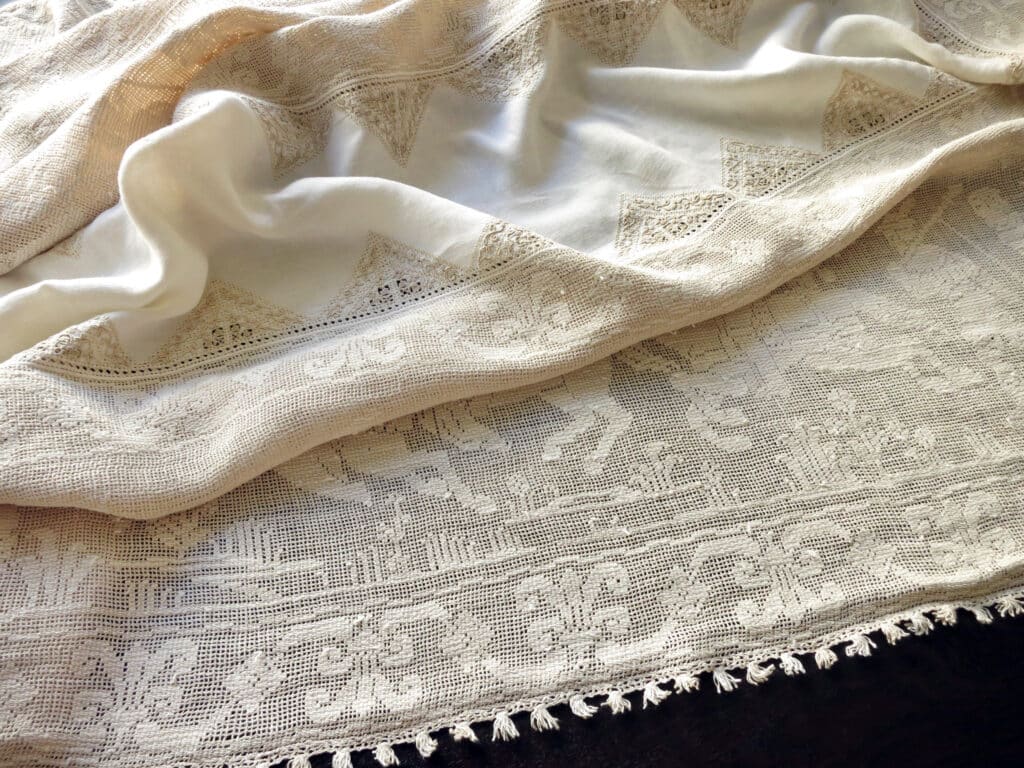The word “homespun” today is often used pejoratively to say someone or something is “simple” and “unsophisticated” as it relates to look, fashion, or philosophy but its origin in the American vernacular has far more noble and patriotic roots.
In the decades of resistance leading up to the War of Independence, Americans throughout the colonies began boycotting the importation of British goods in protest of increased taxation on everyday items, including cloth for sewing clothes and finished fashions. In response, the Quakers in Boston, Massachusetts initiated what became known as a homespun movement in 1767 to encourage colonists to only purchase cotton, linen, and wool textile manufactured in the American Colonies and produce their own garments.
As the popularity of the boycott of British goods grew and spread throughout the Colonies, wearing homespun clothing was seen as a patriotic symbol of the fight against British rule. Women in particular took a leading role in the movement in the most socially-appropriate fashion for that time. They avoided imported satin and silk in favor of locally-made materials to spin cloths, created a cottage industry for spinners, weavers, and seamstresses to support domestic demand, turned spinning into a social event and showed their support for the cause by wearing their homespun garments in public with great pride like Martha Washington.
Homespun fabric even became a political statement for Americans visiting England. Edmund Jenings, a Virginia-born lawyer who lived in London, wrote a letter to Richard Henry Lee informing him of his new clothing. He wrote, “Your brother has given me cloth made in your family I wear it on all occasions to show the politicians of this country that the sheep of America have not hair on their backs. — They can hardly believe their eyes.”
Homespun took on even greater urgency on Dec. 1, 1774, when the final nonimportation agreement was signed by the first Continental Congress. The Colonies would no longer import any goods, including textiles, from Great Britain. Virginians along with the other 12 American Colonies would now need to produce all the textiles for their households and apparel, a nearly impossible task if not for the resolve, sacrifice, and employ of colonial women.
In her book, “The Age of Homespun,” historian Laurel Thatcher Ulrich notes that the nonimportation movement of the 1760s gave cloth-making a significance it had never had before. Stories about spinning meetings and contests in the local papers helped to spread homespun fever and engage women of all ages:
“In Boston, patriotic merchants revived the spinning schools. In Hartford, members of a society for promoting arts, agriculture, and commerce offered a bounty of twelve pounds to the person who manufactured the most yards of woolen cloth in a year. In Newport, the editor of the Mercury displayed at his printing office ‘a Sample of Cloth, made by a Young Lady in this Town, which is equal in Width, Fineness, and Goodness, to an English Plain.’
Newspapers trumpeted even the smallest success. In Newport, Rhode Island, a seventy-year-old woman who had ‘never spun a thread in her life before’ became a very good spinner. In Windham, Connecticut, one woman raised six thousand silk balls from a single mulberry tree. In Sutherland, Massachusetts, a lady of fashion made and quilted a petticoat from remnants in her scrapbag, patching together forty-five pieces for the outside and ninety-two for the lining”
While the women focused on the production and industry of turning raw materials sourced in the American colonies into American-made finished goods, their husbands were looking at ways to circumvent the laws that restricted the resale of the wool, wool yarn, and wool cloth they produced for export to England, and provide a new industry for their plantations to meet this homespun demand. The answer came in the form of flax and hemp, two plants not commonly associated today with clothing but at the time, potentially more profitable for some famers and plantation owners than growing tobacco.
The outbreak of war in April 1775 would create an even larger problem for Colonists: clothing and equipping an infant army and navy. According to an article on the Colonial Williamsburg website, “The military needed enormous amounts of textiles for clothing, tents, knapsacks, haversacks and blankets. Initially, tens of thousands of yards of fabric arrived in storehouses across the Colonies, including both pieces bought before the nonimportation agreements and homespun woven in homes, farms and plantations. These materials were quickly depleted, and more were immediately needed. With no imports coming from Great Britain and domestic production not meeting the demand, the American army faced major supply shortages.
Dressed in a very plain manner with a pine marten fur cap, Benjamin Franklin was dispatched to the court of France for help to get materials, especially textiles, for its newly established military force. The French Court admired Franklin and his unique American dress, which they may have believed was homespun. Franklin secured the Treaty of Alliance between the newly formed United States of America and the French that allowed these much needed supplies to flow into the United States.”
After the war, Americans continued to produce homespun fabrics as wardrobe supplements but returned to importing their higher-end textiles and fashionable garments from England. Once again, merchants found it cheaper to import these high-quality English goods than invest in a new domestic industry. That fashion trend, however, was about to change.
At his inauguration on April 30, 1789, George Washington wore a brown broadcloth three-piece suit made from fabric woven at the Hartford Woolen Manufactory, a newly established business in Connecticut. By choosing American-produced broadcloth for his first inaugural suit, Washington, known as a bit of a clothes horse with a history of importing the latest fashions from the best fabrics, showed his leadership support for the economic and industrial growth of the new republic with a boost to the American textile industry. Today, that uniquely American homespun industry represents $1.5 trillion in annual sales!
Homespun? High praise, indeed!





Related posts: